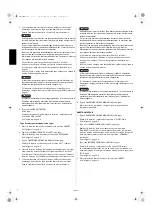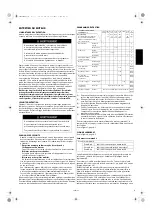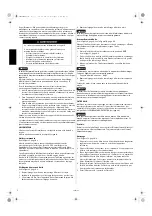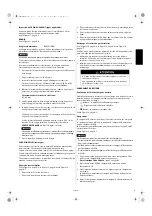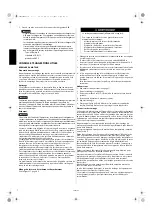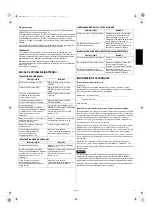
5
ENGLISH
or performance problems that result from using a fuel with
percentages of ethanol or methanol greater than shown above are
not covered under the Warranty.
Fuel can damage paint and some types of plastic. Be careful not to spill fuel
when filling your fuel tank. Damage caused by spilled fuel is not covered
under the Warranty.
Never use gasoline that is stale, contaminated, or mixed with oil. Avoid
getting dirt or water in the fuel tank.
Refer to the instructions provided with the equipment powered by this
engine for refuelling.
1. With the engine stopped and on a level surface, remove the fuel tank
cap and check the fuel level. Refill the tank if the fuel level is low.
2. Add fuel to the upper level of the fuel tank. Wipe up spilled fuel
before starting the engine.
3. Refuel carefully to avoid spilling fuel. Do not overfill the fuel tank
(there should be no fuel in the fuel filler neck). It may be necessary to
lower the fuel level depending on operating conditions. After
refueling, tighten the fuel tank cap securely.
Keep gasoline away from appliance pilot lights, barbecues, electric
appliances, power tools, etc.
Spilled fuel is not only a fire hazard, it causes environmental damage.
Wipe up spills immediately.
ENGINE OIL
Oil is a major factor affecting performance and service life.
Use 4-stroke automotive detergent oil.
Recommended Oil
See Figure 9, page A-3.
Use 4-stroke motor oil that meets or exceeds the requirements for API
service category SE or later (or equivalent). Always check the API service
label on the oil container to be sure it includes the letters SE or later (or
equivalent).
Lubrication oil specifications necessary to maintain the performance of
the emissions control system: Honda genuine oil.
SAE 10W-30 is recommended for general use. Other viscosities shown in
the chart may be used when the average temperature in your area is
within the indicated range.
Oil Level Check
See Figure 8, page A-3.
1. Remove the oil filler cap/dipstick and wipe it clean.
2. Insert the dipstick into the oil filler neck, but do not screw it in.
3. If the level is low, add the recommended oil to the upper limit on the
dipstick.
4. Install the oil filler cap/dipstick.
Running the engine with a low oil level can cause engine damage. This type
of damage is not covered under the Warranty.
Oil Change
See Figure 8, page A-3 and Figure 10, page A-3.
Drain the used oil when the engine is warm. Warm oil drains quickly and
completely.
1. Turn the fuel valve lever to the OFF position.
See Figure 1, page A-2.
2. Remove the oil filler cap and drain the oil into the oil container by
inclining the engine toward the oil filler neck.
3. Refill with the recommended oil and check the oil level.
Running the engine with a low oil level can cause engine damage.
This type of damage is not covered under the Warranty.
Engine oil capacity: 0.40 L (14 US oz, 0.35 Imp qt)
4. Install the oil filler cap/dipstick securely.
Wash your hands with soap and water after handling used oil.
Please dispose of used motor oil in a manner that is compatible with the
environment.We suggest you take it in a sealed container to your local
service station for reclamation. Do not throw it in the trash, pour it on the
ground, or pour it down a drain.
AIR CLEANER
A dirty air cleaner will restrict air flow to the carburetor, reducing engine
performance. If you operate the engine in very dusty areas, clean the air
filter more often than specified in the
MAINTENANCE SCHEDULE
(see
page 4).
Operating the engine without an air filter, or with a damaged air filter, will
allow dirt to enter the engine, causing rapid engine wear. This type of damage is
not covered under the Warranty.
Inspection
Remove the air cleaner cover and inspect the filter element. Clean or
replace a dirty filter element. Always replace a damaged filter element.
Cleaning
See Figure 12, page A-4.
1. Remove the air cleaner cover by unhooking the two upper tabs on
the top of the air cleaner cover and the two lower tabs.
2. Remove the element. Carefully check the element for holes or tears
and replace if damaged.
3. Tap the element lightly several times on a hard surface to remove
excess dirt, or blow compressed air 29 psi (200 kPa) through the filter
from the inside out. Never try to brush the dirt off; brushing will force
dirt into the fibers. Replace the element if it is excessively dirty.
4. Wipe dirt from the inside of the air cleaner case and cover using a
moist rag. Be careful to prevent dirt from entering the air duct that
leads to the carburetor.
5. Install the element and the air cleaner cover.
Gasoline is highly flammable and explosive.
You can be burned or seriously injured when handling
fuel.
• Stop the engine and let it cool before handling fuel.
• Keep heat, sparks, and flame away.
• Handle fuel only outdoors.
• Keep away from your vehicle.
• Wipe up spills immediately.
3RZ9S8000.book 5 ページ 2019年9月3日 火曜日 午後4時17分




















